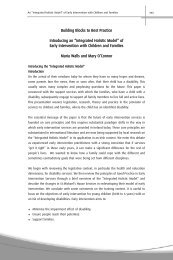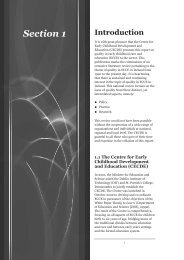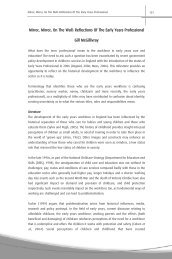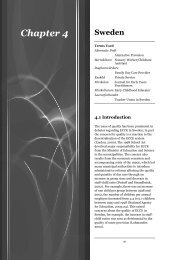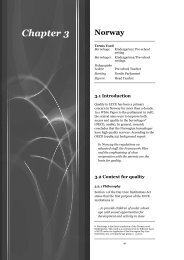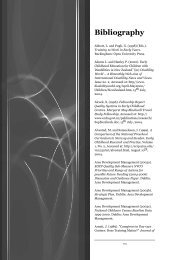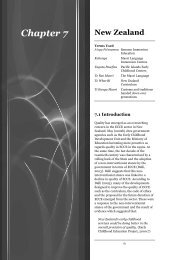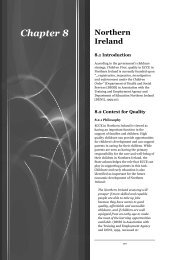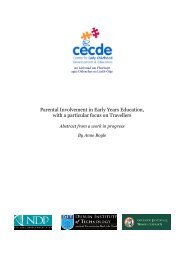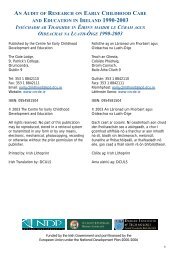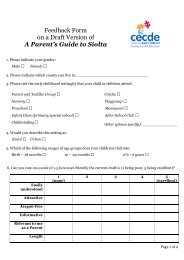Policy Developments 1990-2004 - Centre for Early Childhood ...
Policy Developments 1990-2004 - Centre for Early Childhood ...
Policy Developments 1990-2004 - Centre for Early Childhood ...
Create successful ePaper yourself
Turn your PDF publications into a flip-book with our unique Google optimized e-Paper software.
Section 4<strong>Policy</strong> <strong>Developments</strong> <strong>1990</strong>-<strong>2004</strong>benefits to the individual child, but also inthe long-term consequences in relation tothe economy and society. Conversely, theeffects of poor quality services are outlined,which are noted as being possibly“…detrimental to childcare.” (DJELR,1999:52)The National Childcare Strategy alsoattempts to delineate the multipleperspectives from which quality can beviewed, interpreted and defined,elucidating the complexity which surroundsthe production of a comprehensivedefinition of quality congruent with thestandpoint of all. The following is a list ofpossible viewpoints of stakeholdersevaluating the quality of services, the viewsof which any definition must recognise andincorporate:Child development perspectiveGovernment / Regulatory perspectiveSocial Service perspectiveParent perspectiveChild perspectiveSocial funding policy perspectiveStaff perspectiveCultural perspectives (DJELR, 1999:52).The Report also outlines possible ways ofdefining the quality of services by the use ofindicators, which must be context-specific.Input indicators refer to concrete featuressuch as the premises and equipment andare easily defined. Process indicatorsconsist of the day-to-day happenings suchas relationships and interactions and aremore difficult to define. Lastly, outcomeindicators relate to the impact of provisionsuch as health and well-being.Following on from the recommendations inthe National Childcare Strategy (DJELR,1999) and the White Paper on <strong>Early</strong><strong>Childhood</strong> Education, Ready to Learn,(DES, 1999a) and other policy documents(Coolahan, 1998; OMNA, 2000), theDJELR undertook the production of aModel Framework <strong>for</strong> Education,Training, and ProfessionalDevelopment in the <strong>Early</strong> <strong>Childhood</strong>Care and Education Sector (DJELR,2002a). This also followed on from thegovernment commitment in theProgramme <strong>for</strong> Prosperity and Fairness(Government of Ireland, 1999:119) to fundresearch into training and qualificationsand to this end, the Certifying BodiesSubgroup of the National Childcare CoordinatingCommittee (NCCC) (see EOCPsection below), was established. The ModelFramework outlines the occupationalprofiles and core skills of all personnelworking in the ECCE sector and details howthese profiles should be used to in<strong>for</strong>m thedevelopment of education and trainingprogrammes. In its Foreword, the Minister<strong>for</strong> Justice, Equality and Law Re<strong>for</strong>moutlines the core necessity of appropriatetraining and qualifications to achievequality within the sector and <strong>for</strong> thedevelopment of the sector:The issue of quality in any sector isinextricably linked to the issues oftraining, education and professionaldevelopment. (DJELR, 2002a:3)A central rationale <strong>for</strong> the development ofcore skills and occupational profiles also isto ensure that quality in services can beassessed and evaluated. As was statedwithin the document:Quality assurance is a way toorganise and manage activities sothat they are in<strong>for</strong>med by, and canbe evaluated against, a set of agreedstandards. (DJELR, 2002a:30)The Model Framework also elucidates themultiple perspectives present in anydefinition of quality <strong>for</strong> ECCE. Thecomplexity, yet necessity, entailed inincorporating the viewpoints of the variousstakeholders within services is alsostressed. This document lists suchperspectives as follows:17



